外研版(2019)必修第一册 Unit6At one with nature Using language公开课课件(44张ppt)
文档属性
| 名称 | 外研版(2019)必修第一册 Unit6At one with nature Using language公开课课件(44张ppt) | 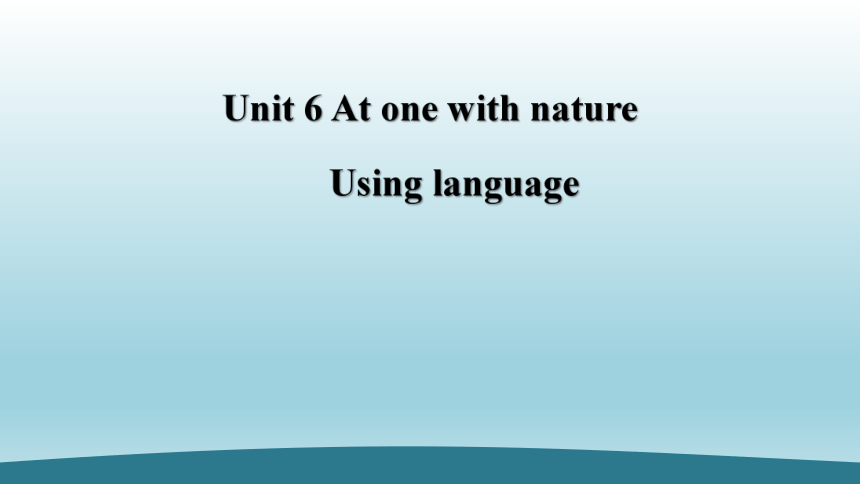 | |
| 格式 | pptx | ||
| 文件大小 | 902.0KB | ||
| 资源类型 | 教案 | ||
| 版本资源 | 外研版(2019) | ||
| 科目 | 英语 | ||
| 更新时间 | 2023-02-26 13:39:01 | ||
图片预览

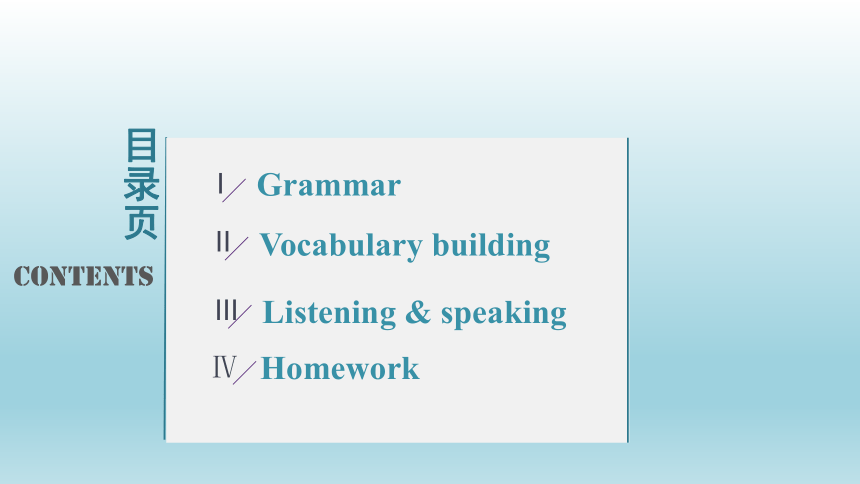

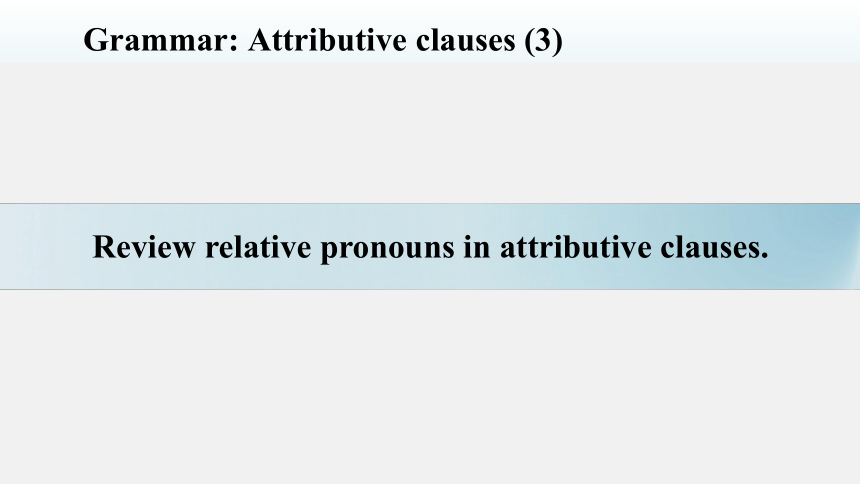
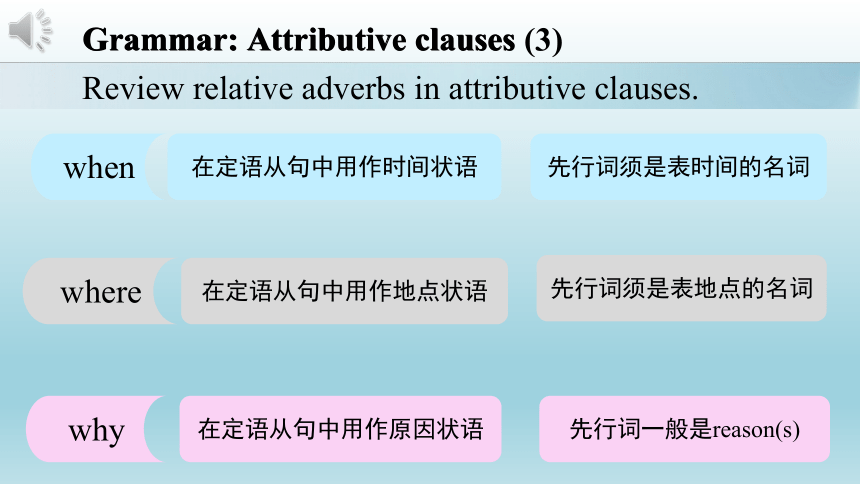
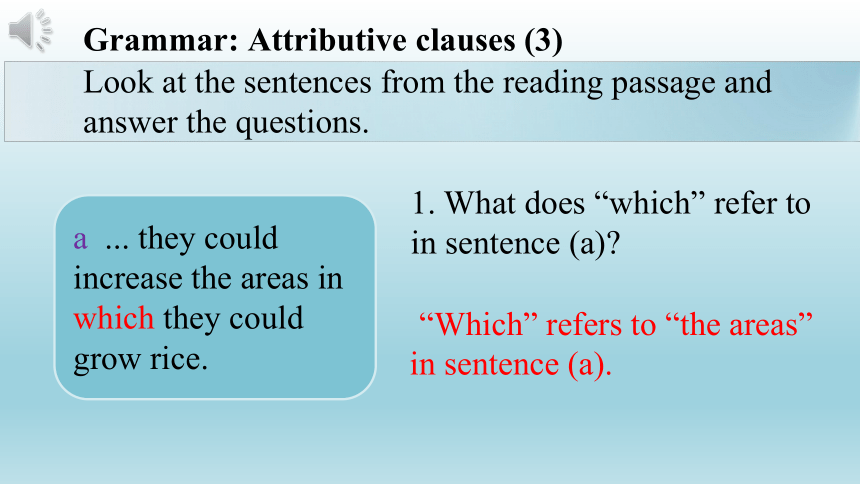
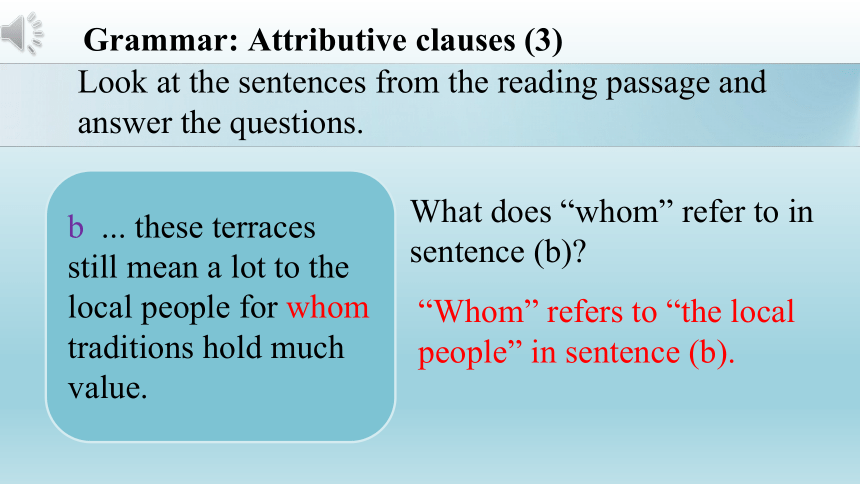
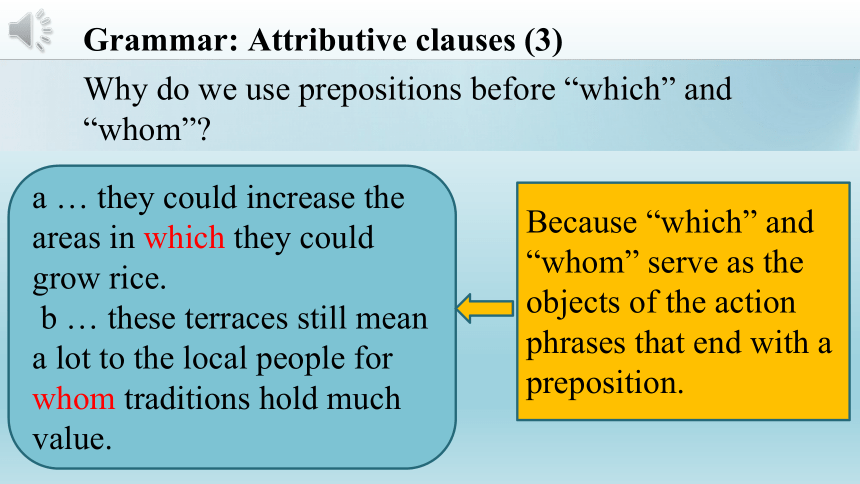

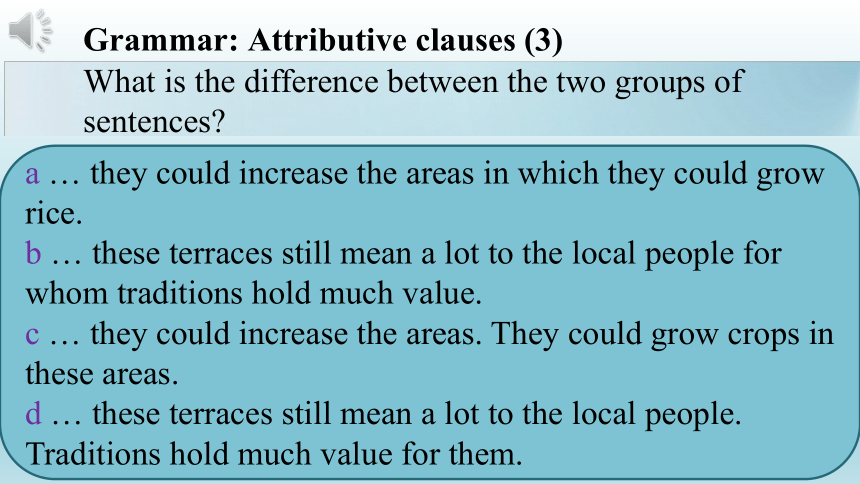
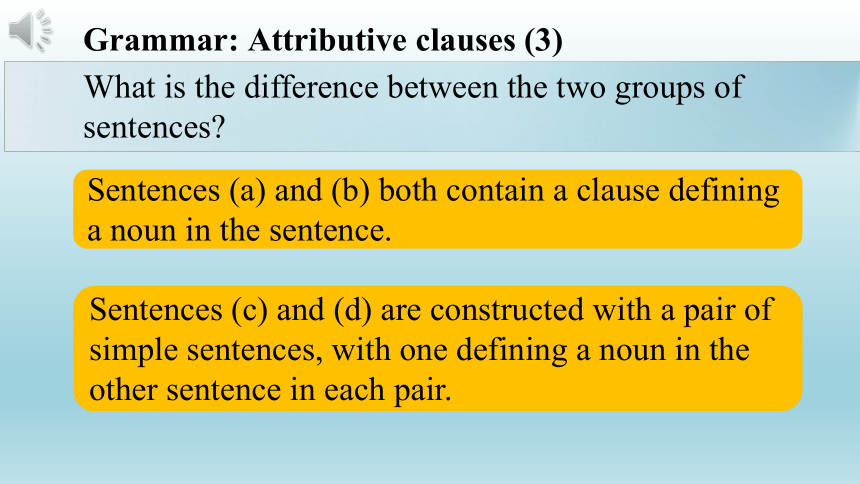

文档简介
(共44张PPT)
Unit 6 At one with nature
Using language
目录页
Grammar
I
Homework
Ⅳ
Vocabulary building
II
Listening & speaking
III
contents
Ⅰ
Grammar
that
指人
指物
主语
宾语
主语
宾语
whose
who
whom
which
指人的或物的
Grammar: Attributive clauses (3)
Review relative pronouns in attributive clauses.
Grammar: Attributive clauses
where
在定语从句中用作地点状语
先行词须是表时间的名词
when
在定语从句中用作原因状语
在定语从句中用作时间状语
先行词须是表地点的名词
先行词一般是reason(s)
why
Grammar: Attributive clauses (3)
Review relative adverbs in attributive clauses.
Grammar: Attributive clauses (3)
Look at the sentences from the reading passage and answer the questions.
a ... they could increase the areas in which they could grow rice.
1. What does “which” refer to in sentence (a)
“Which” refers to “the areas” in sentence (a).
Grammar: Attributive clauses (3)
Look at the sentences from the reading passage and answer the questions.
b ... these terraces still mean a lot to the local people for whom traditions hold much value.
What does “whom” refer to in sentence (b)
“Whom” refers to “the local people” in sentence (b).
Grammar: Attributive clauses (3)
Why do we use prepositions before “which” and “whom”
a … they could increase the areas in which they could grow rice.
b … these terraces still mean a lot to the local people for whom traditions hold much value.
Because “which” and “whom” serve as the objects of the action phrases that end with a preposition.
In sentence (a), can we replace “in which” with “where” without changing the meaning
Grammar: Attributive clauses (3)
a … they could increase the areas in which they could grow rice.
Yes.
Grammar: Attributive clauses (3)
What is the difference between the two groups of sentences
a … they could increase the areas in which they could grow rice.
b … these terraces still mean a lot to the local people for whom traditions hold much value.
c … they could increase the areas. They could grow crops in these areas.
d … these terraces still mean a lot to the local people. Traditions hold much value for them.
Grammar: Attributive clauses (3)
What is the difference between the two groups of sentences
Sentences (c) and (d) are constructed with a pair of simple sentences, with one defining a noun in the other sentence in each pair.
Sentences (a) and (b) both contain a clause defining a noun in the sentence.
Grammar: Attributive clauses (3)
Why does the author choose to use sentences (a) and (b) in the reading passage
Because there is a closer link and connection between the item and the clause defining it in sentences (a) and (b). It will also make the passage clearer, and create an emphatic effect on the objects being defined.
Grammar: Attributive clauses (3)
介词 + 关系代词
指人
指物
介词 + whom
介词 + which
Grammar: Attributive clauses (3)
练一练:
1)The man______________ the thief was caught was a good policeman.
2)This is the reason ______________ I was praised by my chemistry teacher.
3)I met the child ________ I looked after ten years ago.
4)I wanted to visit the house ______________my grandparents lived in.
by whom
for which
whom
(which)
含有介词的动词固定短语在定语从句中一般不拆开, 在这种情况下,介词仍然放在后面,例如 hear from, look after 等。
介词处于句尾时,句中的关系代词可以省略。
Grammar: Attributive clauses (3)
Now look for and underline the sentences with attributive clauses in the reading passage.
These terraces were built by the local Zhuang and Yao people, to whom Guangxi is home.
Building the terraces therefore meant that they could increase the areas in which they could grow rice.
But perhaps what is most significant is the way in which people have worked in harmony with nature to make these terraces and grow rice.
1.
2.
3.
Grammar: Attributive clauses (3)
Now look for and underline the sentences with attributive clauses in the reading passage.
The terraces are cleverly designed, with hundreds of waterways that connect with each other.
This forms clouds from which rain falls down onto the mountain terraces once again.
These terraces also provide a perfect environment for birds and fish, some of which feed on insects that can harm the rice crops.
4.
5.
6.
Grammar: Attributive clauses (3)
Now look for and underline the sentences with attributive clauses in the reading passage.
Although modern technology could help produce more crops, these terraces still mean a lot to the local people for whom traditions hold much value.
This knowledge is passed down through families, which means that new generations continue to use ancient methods of agriculture to maintain the terraces.
7.
8.
Grammar: Attributive clauses (3)
Now look for and underline the sentences with attributive clauses in the reading passage.
Today, the Longji Rice Terraces attract thousands of visitors who come to admire this great wonder created by people and nature working together.
9.
Grammar: Attributive clauses (3)
Connect the sentences with a preposition + whom / which.
1. The Zhuang is an ethnic group. Its population is the largest of all ethnic groups in China.
2 Guangxi is a province. The Longji Rice Terraces are located in it.
The Zhuang is an ethnic group, of which the population is the largest of all ethnic groups in China.
Guangxi is a province in which the Longji Rice Terraces are located.
Grammar: Attributive clauses (3)
Connect the sentences with a preposition + whom / which.
3. I want to visit this cultural landscape. The title of UNESCO World Heritage Site was given to it in 2016.
4. He is an expert on rice planting. The local Zhuang people have learnt a lot from him.
I want to visit this cultural landscape, to which the title of UNESCO World Heritage Site was given in 2016.
He is an expert on rice planting, from whom the local Zhuang people have learnt a lot.
Grammar: Attributive clauses (3)
Complete the passage with a preposition + whom / which.
Among the many beautiful treasures people can receive from nature are natural dyes. The most common natural source 1. _____________ natural dyes come is plants.
from which
Grammar: Attributive clauses (3)
Complete the passage with a preposition + whom / which.
Materials for making natural dyes can often be found in gardens 2. __________ colorful flowers are planted. Other natural dyes are made from insects, sea creatures and mineral compounds.
in which
Grammar: Attributive clauses (3)
Complete the passage with a preposition + whom / which.
Natural dyes are now returning to popularity, especially with artists and craftspeople. The reasons
3. ___________ they prefer natural dyes are that the colors are brighter and can be kept longer.
for which
Grammar: Attributive clauses (3)
Complete the passage with a preposition + whom / which.
Natural dyes are also becoming more popular with consumers
4. ______________ caring for the environment is a priority. More and more people feel that by using natural dyes, we can remind ourselves of nature’s beauty and protect the natural world.
for whom
Ⅱ
Vocabulary building
Vocabulary building: Geographical features
Read the descriptions and match them to the pictures.
Located off the coast of Australia, the Great Barrier Reef is the biggest structure made by living organisms. You can explore the Great Barrier Reef by visiting an underwater observatory.
a
Vocabulary building: Geographical features
Read the descriptions and match them to the pictures.
Part of the Colorado River Basin Canyon, the Grand Canyon is a valley that is almost two kilometres deep. Tourists can stand on a narrow glass platform called the Skywalk to see the Grand Canyon.
c
Vocabulary building: Geographical features
Read the descriptions and match them to the pictures.
Victoria Falls is the largest waterfall in the world. The local people call it “the smoke that thunders”. The Victoria Falls Bridge connects the countries Zimbabwe and Zambia.
d
Vocabulary building: Geographical features
Read the descriptions and match them to the pictures.
The English Channel separates England from France. These two countries are joined by the Channel Tunnel, a rail tunnel with a length of about 50 kilometres, most of which is under the sea.
b
Vocabulary building: Geographical features
Complete the email with the words in bold in Activity 4.
From
To
Subject
Emma
Jane
Hello from
Guizhou!
Huangguoshu Waterfall.MP4
Vocabulary building: Geographical features
Hi Jane,
I’m now back in the hotel after a fantastic day exploring Huangguoshu National Park. The park is most famous for its 1. ____________. Check out this video that I made – it shows the water falling into the deep 2. _______ below.
waterfall
valley
Complete the email with the words in bold in Activity 4.
Vocabulary building: Geographical features
Next week we are flying to the Turpan 3. _________ in Xinjiang, which is famous for its sweet grapes. I’ve heard that grapes are dried in drying houses to make raisins. The walls of the houses have a lot of holes in them to allow wind to pass through.
Basin
Complete the email with the words in bold in Activity 4.
Vocabulary building: Geographical features
How clever! We are also going to ride camels, “the ships of the desert”. It sounds like I will be sailing on a(n) 4. _________ of sand!
See you soon.
Emma
sea / ocean
Complete the email with the words in bold in Activity 4.
Vocabulary building: Geographical features
1. plain
2. plateau
3. Danxia landform
4. karst
5. lagoon
6. bay
平原
高原
丹霞地貌
喀斯特
潟(xì)湖
海湾、湖湾
Work in pairs. Talk about other geographical features in the world.
Vocabulary building: Geographical features
7. desert
8. Gobi
9. coast
10. glacier
11. isthmus
12. swamp
沙漠
戈壁(沙 漠)
海岸
冰川
地峡
沼泽(地)
Work in pairs. Talk about other geographical features in the world.
III
Listening & speaking
Listening & speaking: Before listening
Around four million people live in the Arctic region, of whom around 170,000 are Inuit.
In the Arctic, the temperature can reach as low as —70°C.
The Arctic includes parts of eight countries: Canada, Russia, the United States, Denmark, Norway, Iceland, Sweden and Finland.
When you hear a word that you don’t recognize, don’t panic! Try to note down how it sounds, and keep listening. When you have finished listening, try to work out the meaning from the context of the word.
Listening & speaking: Before listening
Learning to learn
…….
……..
……..
Listening & speaking: While-listening
Listen to a girl talking about Inuit life and identify the things that are mentioned.
Listening & speaking: Speaking
Inuit life Advantages Disadvantages
Housing Igloos are quite warm inside and it’s easy to find the 1. _______________ . Igloos can only
2. __________ for around 50 days.
Food Eating a lot of fish and meat keeps our bodies strong so that we can 3. ________________. The 4. ____________ makes it difficult for us to grow enough vegetables and fruit.
building materials
be kept
fight the cold
cold weather
Listening & speaking: Speaking
Inuit life Advantages Disadvantage
Polar night It gives us more 5. ________ to be with our family and friend. Life can be
6. _______ sometimes.
Tourism It brings more money and 7. ________________ . Our environment is being8. _________ .
time
boring
job opportunities
polluted
Listening & speaking: Speaking
discussion
Student A: Turn to Page 83.
Student B: Turn to Page 86.
Work in pairs. Talk about life in the tropics and the Arctic.
Ⅳ
Homework
Homework
1. Review attributive clauses and do more exercises about them.
2. Memorize some words about geographical features.
3. Talk about the differences between life in
southern China and northern China.
Unit 6 At one with nature
Using language
目录页
Grammar
I
Homework
Ⅳ
Vocabulary building
II
Listening & speaking
III
contents
Ⅰ
Grammar
that
指人
指物
主语
宾语
主语
宾语
whose
who
whom
which
指人的或物的
Grammar: Attributive clauses (3)
Review relative pronouns in attributive clauses.
Grammar: Attributive clauses
where
在定语从句中用作地点状语
先行词须是表时间的名词
when
在定语从句中用作原因状语
在定语从句中用作时间状语
先行词须是表地点的名词
先行词一般是reason(s)
why
Grammar: Attributive clauses (3)
Review relative adverbs in attributive clauses.
Grammar: Attributive clauses (3)
Look at the sentences from the reading passage and answer the questions.
a ... they could increase the areas in which they could grow rice.
1. What does “which” refer to in sentence (a)
“Which” refers to “the areas” in sentence (a).
Grammar: Attributive clauses (3)
Look at the sentences from the reading passage and answer the questions.
b ... these terraces still mean a lot to the local people for whom traditions hold much value.
What does “whom” refer to in sentence (b)
“Whom” refers to “the local people” in sentence (b).
Grammar: Attributive clauses (3)
Why do we use prepositions before “which” and “whom”
a … they could increase the areas in which they could grow rice.
b … these terraces still mean a lot to the local people for whom traditions hold much value.
Because “which” and “whom” serve as the objects of the action phrases that end with a preposition.
In sentence (a), can we replace “in which” with “where” without changing the meaning
Grammar: Attributive clauses (3)
a … they could increase the areas in which they could grow rice.
Yes.
Grammar: Attributive clauses (3)
What is the difference between the two groups of sentences
a … they could increase the areas in which they could grow rice.
b … these terraces still mean a lot to the local people for whom traditions hold much value.
c … they could increase the areas. They could grow crops in these areas.
d … these terraces still mean a lot to the local people. Traditions hold much value for them.
Grammar: Attributive clauses (3)
What is the difference between the two groups of sentences
Sentences (c) and (d) are constructed with a pair of simple sentences, with one defining a noun in the other sentence in each pair.
Sentences (a) and (b) both contain a clause defining a noun in the sentence.
Grammar: Attributive clauses (3)
Why does the author choose to use sentences (a) and (b) in the reading passage
Because there is a closer link and connection between the item and the clause defining it in sentences (a) and (b). It will also make the passage clearer, and create an emphatic effect on the objects being defined.
Grammar: Attributive clauses (3)
介词 + 关系代词
指人
指物
介词 + whom
介词 + which
Grammar: Attributive clauses (3)
练一练:
1)The man______________ the thief was caught was a good policeman.
2)This is the reason ______________ I was praised by my chemistry teacher.
3)I met the child ________ I looked after ten years ago.
4)I wanted to visit the house ______________my grandparents lived in.
by whom
for which
whom
(which)
含有介词的动词固定短语在定语从句中一般不拆开, 在这种情况下,介词仍然放在后面,例如 hear from, look after 等。
介词处于句尾时,句中的关系代词可以省略。
Grammar: Attributive clauses (3)
Now look for and underline the sentences with attributive clauses in the reading passage.
These terraces were built by the local Zhuang and Yao people, to whom Guangxi is home.
Building the terraces therefore meant that they could increase the areas in which they could grow rice.
But perhaps what is most significant is the way in which people have worked in harmony with nature to make these terraces and grow rice.
1.
2.
3.
Grammar: Attributive clauses (3)
Now look for and underline the sentences with attributive clauses in the reading passage.
The terraces are cleverly designed, with hundreds of waterways that connect with each other.
This forms clouds from which rain falls down onto the mountain terraces once again.
These terraces also provide a perfect environment for birds and fish, some of which feed on insects that can harm the rice crops.
4.
5.
6.
Grammar: Attributive clauses (3)
Now look for and underline the sentences with attributive clauses in the reading passage.
Although modern technology could help produce more crops, these terraces still mean a lot to the local people for whom traditions hold much value.
This knowledge is passed down through families, which means that new generations continue to use ancient methods of agriculture to maintain the terraces.
7.
8.
Grammar: Attributive clauses (3)
Now look for and underline the sentences with attributive clauses in the reading passage.
Today, the Longji Rice Terraces attract thousands of visitors who come to admire this great wonder created by people and nature working together.
9.
Grammar: Attributive clauses (3)
Connect the sentences with a preposition + whom / which.
1. The Zhuang is an ethnic group. Its population is the largest of all ethnic groups in China.
2 Guangxi is a province. The Longji Rice Terraces are located in it.
The Zhuang is an ethnic group, of which the population is the largest of all ethnic groups in China.
Guangxi is a province in which the Longji Rice Terraces are located.
Grammar: Attributive clauses (3)
Connect the sentences with a preposition + whom / which.
3. I want to visit this cultural landscape. The title of UNESCO World Heritage Site was given to it in 2016.
4. He is an expert on rice planting. The local Zhuang people have learnt a lot from him.
I want to visit this cultural landscape, to which the title of UNESCO World Heritage Site was given in 2016.
He is an expert on rice planting, from whom the local Zhuang people have learnt a lot.
Grammar: Attributive clauses (3)
Complete the passage with a preposition + whom / which.
Among the many beautiful treasures people can receive from nature are natural dyes. The most common natural source 1. _____________ natural dyes come is plants.
from which
Grammar: Attributive clauses (3)
Complete the passage with a preposition + whom / which.
Materials for making natural dyes can often be found in gardens 2. __________ colorful flowers are planted. Other natural dyes are made from insects, sea creatures and mineral compounds.
in which
Grammar: Attributive clauses (3)
Complete the passage with a preposition + whom / which.
Natural dyes are now returning to popularity, especially with artists and craftspeople. The reasons
3. ___________ they prefer natural dyes are that the colors are brighter and can be kept longer.
for which
Grammar: Attributive clauses (3)
Complete the passage with a preposition + whom / which.
Natural dyes are also becoming more popular with consumers
4. ______________ caring for the environment is a priority. More and more people feel that by using natural dyes, we can remind ourselves of nature’s beauty and protect the natural world.
for whom
Ⅱ
Vocabulary building
Vocabulary building: Geographical features
Read the descriptions and match them to the pictures.
Located off the coast of Australia, the Great Barrier Reef is the biggest structure made by living organisms. You can explore the Great Barrier Reef by visiting an underwater observatory.
a
Vocabulary building: Geographical features
Read the descriptions and match them to the pictures.
Part of the Colorado River Basin Canyon, the Grand Canyon is a valley that is almost two kilometres deep. Tourists can stand on a narrow glass platform called the Skywalk to see the Grand Canyon.
c
Vocabulary building: Geographical features
Read the descriptions and match them to the pictures.
Victoria Falls is the largest waterfall in the world. The local people call it “the smoke that thunders”. The Victoria Falls Bridge connects the countries Zimbabwe and Zambia.
d
Vocabulary building: Geographical features
Read the descriptions and match them to the pictures.
The English Channel separates England from France. These two countries are joined by the Channel Tunnel, a rail tunnel with a length of about 50 kilometres, most of which is under the sea.
b
Vocabulary building: Geographical features
Complete the email with the words in bold in Activity 4.
From
To
Subject
Emma
Jane
Hello from
Guizhou!
Huangguoshu Waterfall.MP4
Vocabulary building: Geographical features
Hi Jane,
I’m now back in the hotel after a fantastic day exploring Huangguoshu National Park. The park is most famous for its 1. ____________. Check out this video that I made – it shows the water falling into the deep 2. _______ below.
waterfall
valley
Complete the email with the words in bold in Activity 4.
Vocabulary building: Geographical features
Next week we are flying to the Turpan 3. _________ in Xinjiang, which is famous for its sweet grapes. I’ve heard that grapes are dried in drying houses to make raisins. The walls of the houses have a lot of holes in them to allow wind to pass through.
Basin
Complete the email with the words in bold in Activity 4.
Vocabulary building: Geographical features
How clever! We are also going to ride camels, “the ships of the desert”. It sounds like I will be sailing on a(n) 4. _________ of sand!
See you soon.
Emma
sea / ocean
Complete the email with the words in bold in Activity 4.
Vocabulary building: Geographical features
1. plain
2. plateau
3. Danxia landform
4. karst
5. lagoon
6. bay
平原
高原
丹霞地貌
喀斯特
潟(xì)湖
海湾、湖湾
Work in pairs. Talk about other geographical features in the world.
Vocabulary building: Geographical features
7. desert
8. Gobi
9. coast
10. glacier
11. isthmus
12. swamp
沙漠
戈壁(沙 漠)
海岸
冰川
地峡
沼泽(地)
Work in pairs. Talk about other geographical features in the world.
III
Listening & speaking
Listening & speaking: Before listening
Around four million people live in the Arctic region, of whom around 170,000 are Inuit.
In the Arctic, the temperature can reach as low as —70°C.
The Arctic includes parts of eight countries: Canada, Russia, the United States, Denmark, Norway, Iceland, Sweden and Finland.
When you hear a word that you don’t recognize, don’t panic! Try to note down how it sounds, and keep listening. When you have finished listening, try to work out the meaning from the context of the word.
Listening & speaking: Before listening
Learning to learn
…….
……..
……..
Listening & speaking: While-listening
Listen to a girl talking about Inuit life and identify the things that are mentioned.
Listening & speaking: Speaking
Inuit life Advantages Disadvantages
Housing Igloos are quite warm inside and it’s easy to find the 1. _______________ . Igloos can only
2. __________ for around 50 days.
Food Eating a lot of fish and meat keeps our bodies strong so that we can 3. ________________. The 4. ____________ makes it difficult for us to grow enough vegetables and fruit.
building materials
be kept
fight the cold
cold weather
Listening & speaking: Speaking
Inuit life Advantages Disadvantage
Polar night It gives us more 5. ________ to be with our family and friend. Life can be
6. _______ sometimes.
Tourism It brings more money and 7. ________________ . Our environment is being8. _________ .
time
boring
job opportunities
polluted
Listening & speaking: Speaking
discussion
Student A: Turn to Page 83.
Student B: Turn to Page 86.
Work in pairs. Talk about life in the tropics and the Arctic.
Ⅳ
Homework
Homework
1. Review attributive clauses and do more exercises about them.
2. Memorize some words about geographical features.
3. Talk about the differences between life in
southern China and northern China.
